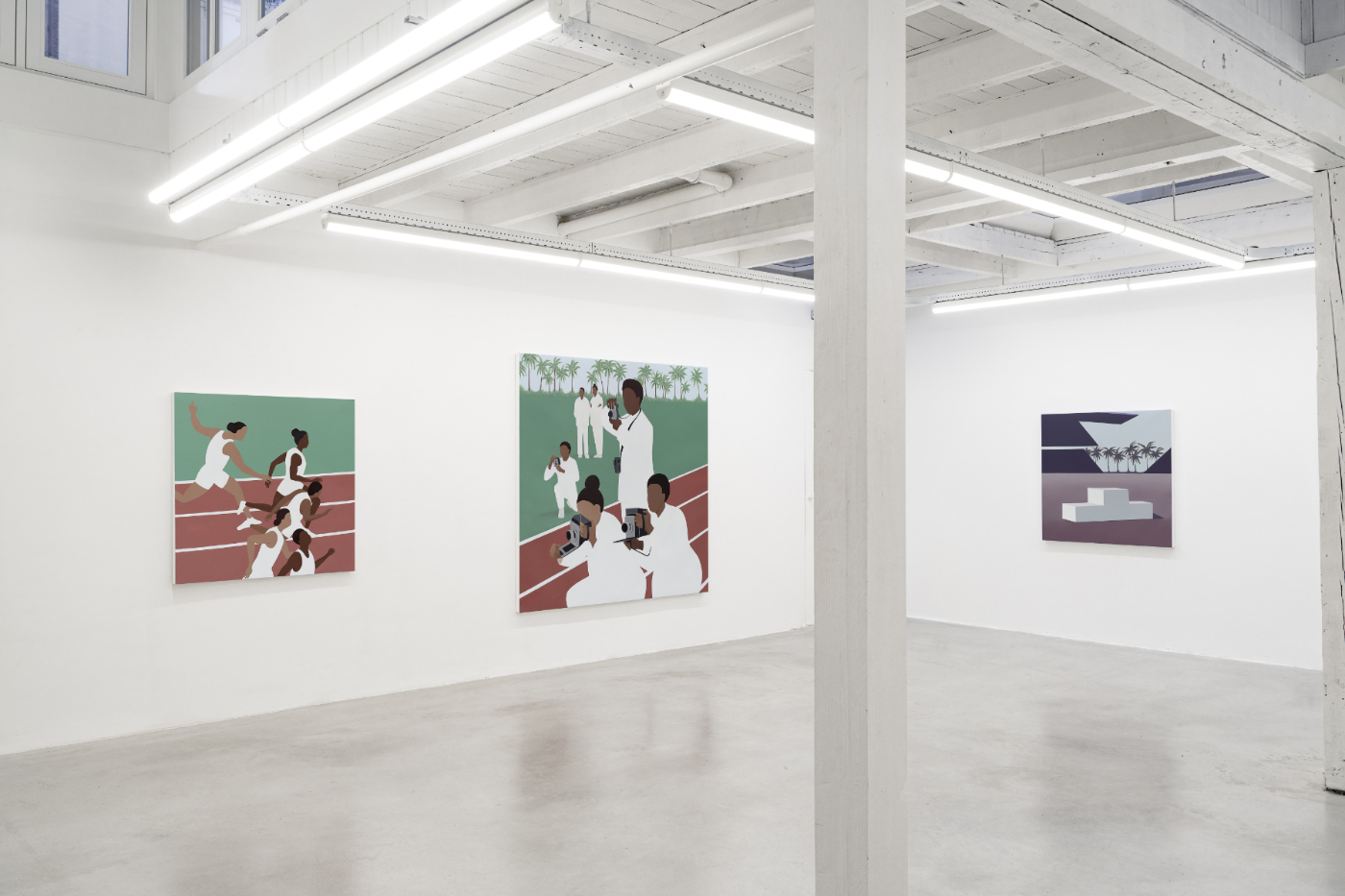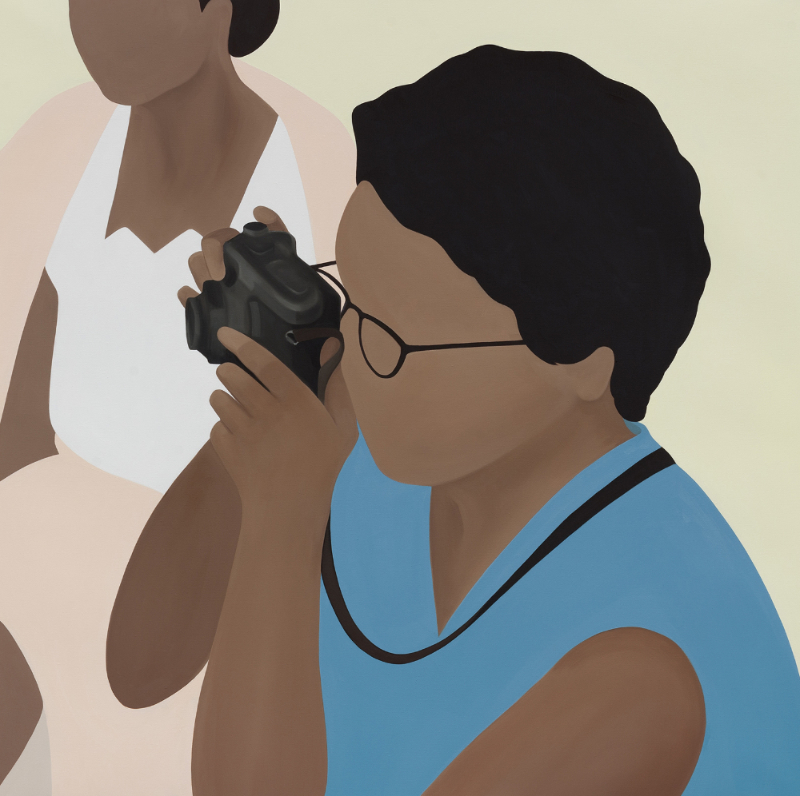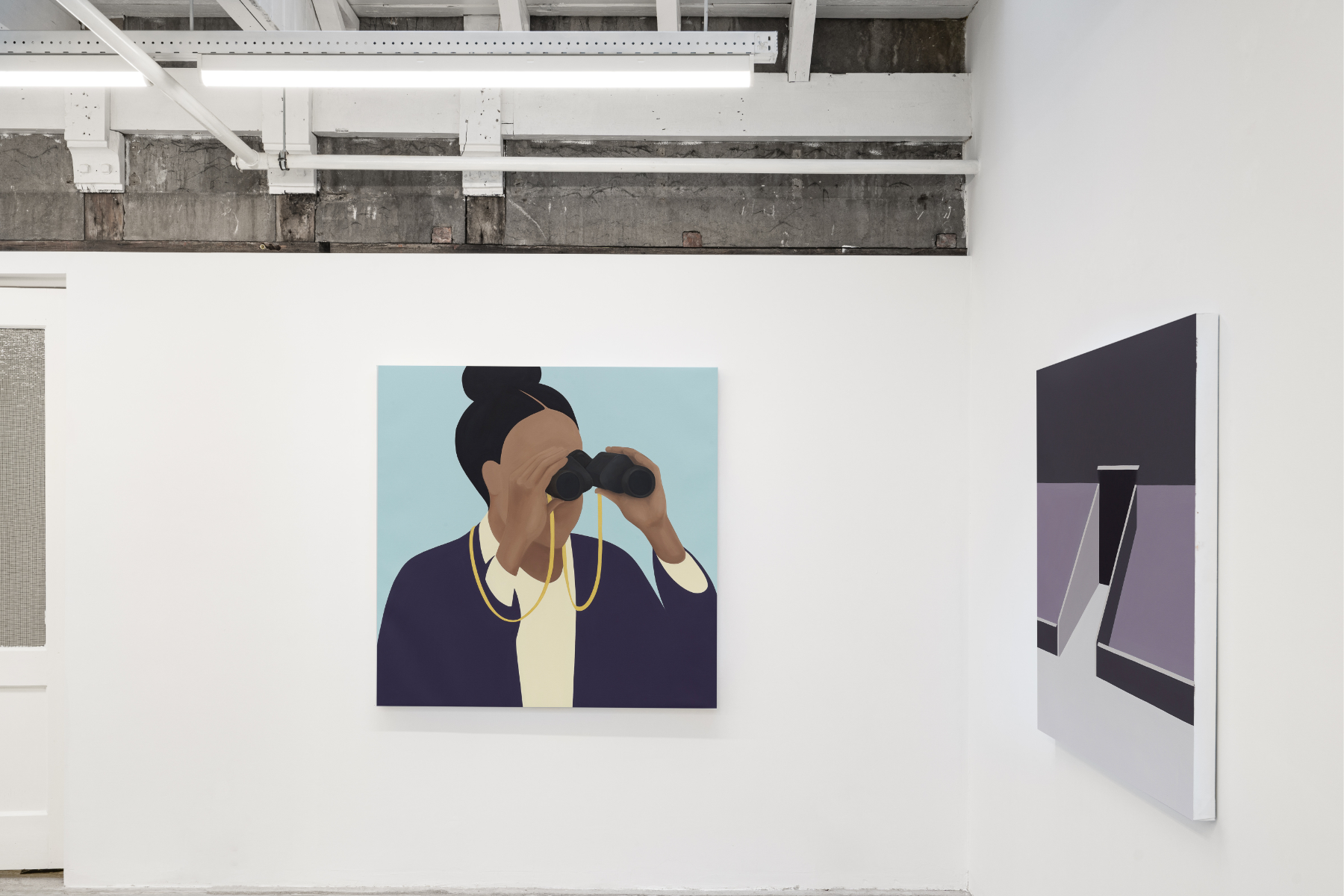Thenjiwe Niki Nkosi Stadium
Stevenson Amsterdam
2 November – 16 December 202314-12-2023
Thenjiwe Niki Nkosi’s exhibition “Stadium” consists of seven new paintings (all 2023) that each capture the simultaneous perspectives intersecting around and within a single track and field race. What struck me upon viewing the works in person — Nkosi’s work, with its bright and supple narrative moments, is widely shared online — was the unexpectedly lush and textured canvases. In recent years, Nkosi has focused her painting on the kinetics and choreography of team sport — track and field and gymnastics—by freeze-framing forms of spectatorship that reveal as well as conceal the ways architecture and administrative infrastructure frame the sporting body. Nkosi's figures — runners, fans, crouching timekeepers and photographers— each constitute a new and arresting visual language that eschews clear iconographic signifiers. In their place, rich texture and color create an electric yet flattened surface under which lies a more complicated consideration of sport as a space of both self-possession and dispossession. Up close, the figures and their settings show the physicality of Nkosi’s Belgian linen canvases, which create points of unexpected dimensionality between overlapping bodies, foreground and background, or the contours of a single figure. Zones of color — royal purple, robin-egg blue, terracotta — at first appear separate, but on closer inspection start to blur together. This is particularly the case with the central narrative anchor, Dead Heat, where a pack of runners overlap; their arms and legs colliding in a collage of transmogrified layers and brushstrokes.

Many of Nkosi’s athletics paintings, with their movement between the specific and the generic, the intimate and the collective, act like history paintings, though of an indeterminate time and place. This indeterminacy primarily arises from the occlusion of identifying facial features, which render subjects akin to a piece of honed material like a tumbled stone or a fleshy flower petal. Especially in the vacant, textured faces of her subjects, Nkosi creates an anti-iconographic iconography — distinct yet reproducible — that reappears again and again in similar forms with human subjects as well as in architectural elements. Passage reduces a darkened stadium tunnel and surrounding grandstand into a geometric composition in lilac and aubergine, as if an attenuated excerpt of one of Bridget Riley’s whirling grids. The discrete shapes and lines offer a rudimentary demonstration of how the gaze might be funneled towards a point of interest in the surrounding paintings, many of which are larger and more explicitly narrative driven.
This exclusion of individualized details could provide a surface for projection and imagination in which new worlds are called to the fore; empty and expectant like the vacant podium set against a lavender background in Equal Elevation (Silver and Bronze). It also seems to highlight the ways in which the triumphant image-making of sport has long been a promotional wing of empire. Sporting events like the Olympics, the World Cup and the Commonwealth Games depend on a representational surface — images of competition, teamwork, overcoming the odds — that inspire the work of national imagination and national belonging while also reassigning the ways labor and the bodies of athletes are exploited in the process. Nkosi, who was born in New York but has spent much of her life in Johannesburg, where she now lives and works, has herself talked about the ways in which the brutal labor necessary to support colonization dovetails with the organized rigor and drama of the sporting spectacle. When I look at Dead Heat and the way the lane lines frame and delimit the runners, even as their bodies rupture that very frame, I see the organized and disciplinary architecture of the gold mine. A dominant part of the South African labor market — though long in decline — the mine marks the landscape with its highly visible slag heaps and vestigial scaffolding above ground and its toiling miners hidden underneath. The brutal and extractive mining industry and the feel-good world of sport both depend on the discipline, strength and endurance of a laboring body, though sporting institutions may claim that all participating members benefit from its glories. With a few exceptions, “Stadium” is noticeably muted especially in comparison to the pastel electricity of Nkosi's earlier gymnastics series, and much of the action and the anticipation is rendered ephemeral or out-of-frame in the intimated sight lines that connect the vantage point in one work to the source of the gaze in another.

With so much of the tension residing outside and between the paintings, it’s unfortunate that they were crowded into Stevenson’s subterranean gallery space, which felt more like the individual paintings were waiting to be parceled up for sale than a compelling expression of multiplicity. This is the third or fourth exhibition I’ve seen at Stevenson that has passed by with little publicity or programming beyond Stevenson’s own (social) media channels. I've been led to wonder, therefore, what kind of role the newest iteration of this South African staple hopes to play within a commercial gallery scene (and Dutch-language art press) in Amsterdam characterized by its lack of criticality and suspicion of outsiders. Stevenson, founded in 2003, has long been the bastion of support and visibility for South African artists (alongside the older and arguably more internationally-focused Goodman Gallery), with ambitious and established spaces in Cape Town and Johannesburg. In recent years, Stevenson — not just its artists — has been more visible outside of South Africa, cultivating a splashy and down-to-earth presence on social media rarely seen by wealthier blue-chips while promoting their unconventional cooperative ownership structure (which might be more radical, or even actually radical, if it also included cooperative ownership by the artists and staff as well as the directors). The space in Amsterdam opened at the height of the Covid-19 lockdowns in 2020, and has, oddly, shown primarily large-scale painting and photography shows in their cramped space, which exists somewhere between an office, a storage facility and a throwback to the salad days of white cube galleries in which the hanging of work was more a courtesy to facilitate sales than an exhibition practice.

Without the square-meterage necessary to adequately showcase the work of the artists it represents, Stevenson Amsterdam has branched out, collaborating with other spaces in the city. Last year, they supported the co-presentation of a series of haunting multi-channel video works by the artist Simon Gush at diez gallery, housed temporarily in a room of the gargantuan old city courthouse. And though I was excited to see the work in person and its staging was carefully executed, it was tinged by a strange performance of gallery world beneficence, kicked off with the cringe-inducing joint statement: “Sharing real estate is one of the most direct and tangible ways galleries can collaborate.” In a city with an extreme housing crisis (which extends to studio space) and shared within the context of a screening about land restitution, this statement struck me as out of touch, as well as revealing. The use of the term “real estate” instead of “space” or even “network” invokes the powers of commerce, ownership and profit accumulation which are standard practice for commercial galleries. Stevenson might see their artists as directly benefiting from their real estate collaborations, though I’m curious what other models might be available within their purportedly democratic approach to showing and supporting politically-engaged work? Michael Stevenson, the gallery’s co-founder and namesake, was recently quoted on Instagram saying “a gallery is both an economic and an imaginative entity.” But where is the imagination in the Amsterdam branch? Are the economics behind this space the primary way in which an artist like Nkosi is supported? Is that enough?
There seems to be a lot of theorizing by Stevenson of what a commercial gallery could or should be, and their arrival in Amsterdam — at least for this writer — brought with it the promise of a gallery, perhaps not “utopian” in structure, but one that takes time and space to present their artists’ work. Instead, the gallery shows I’ve seen have seemed like a stopover for work on the way to somewhere else. For the paintings in “Stadium,” that somewhere else has a specific location that precedes the series and adds a ghostly layer to the work. In her short film The Same Track (2022), commissioned by Eastside Projects in Birmingham and shown across the city during its hosting of the Commonwealth Games that summer, Nkosi sutured together footage of competition through the years with archival footage of work, protest and daily life across the British colonies and the contemporary Commonwealth. Coursing through four-minute work is a series of track races whose runners have been removed from their lanes. In their place is a rupture or a void in which the track itself starts to buckle and bend, revealing an infrastructure still very much visible, though compromised. The film isn’t included in “Stadium” — you can watch it online — but the absent runners are reconstituted within the paintings even as they’re again de-corporealized into the expectations, imagination and mediation of different forms of spectacle. Here, the processes of de- and re-materialization might intersect with Stevenson’s real estate endeavors in Amsterdam, which as undefined as they may be, also produce an unfinished space, or a space of projection. Perhaps all we need is to just get in the door — if we can find it. To simply encounter the runners and their various spectators up close is to see them settle into the image before they travel on beyond the frame, pacing through our field of vision.